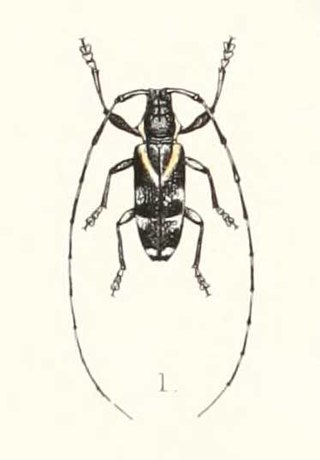
Apomecynini is a tribe of longhorn beetles of the subfamily Lamiinae.

Desmiphorini is a tribe of longhorn beetles of the subfamily Lamiinae.

Saperdini is a tribe of longhorn beetles of the subfamily Lamiinae.

Lamiini is a tribe of longhorn beetles of the subfamily Lamiinae.

Mesosa is a genus of longhorn beetles of the subfamily Lamiinae, containing the following species:

Phytoecia is a genus of longhorn beetles of the subfamily Lamiinae,

Melanopolia frenata is a species of beetle in the family Cerambycidae. It was described by Henry Walter Bates in 1884. It is known from Gabon and the Democratic Republic of the Congo.
Coptosia bithynensis is a species of beetle in the family Cerambycidae. It was described by Ganglbauer in 1884, originally under the genus Phytoecia. It is known from Bulgaria, Turkey, Armenia, and possibly Romania.

Paraglenea fortunei is a species of beetle in the family Cerambycidae. It was described by Saunders in 1853, originally under the genus Glenea. It is known from Taiwan, China, North Korea, South Korea, and Vietnam, and has been introduced into Japan. It feeds on Cinnamomum camphora, Boehmeria nivea, Hibiscus syriacus, Morus alba, and Triadica sebifera.
Phytoecia aterrima is a species of beetle in the family Cerambycidae. It was described by Stephan von Breuning in 1951. It is known from the Democratic Republic of the Congo and Zambia. It contains the varietas Phytoecia aterrima var. gilbertae.
Phytoecia rufa is a species of beetle in the family Cerambycidae. It was described by Stephan von Breuning in 1950.
Phytoecia merkli is a species of beetle in the family Cerambycidae. It was described by Ganglbauer in 1884. It is known from Turkey, Armenia and Jordan. It contains the varietas Phytoecia merkli var. inapicalis.

Phytoecia puncticollis is a species of beetle in the family Cerambycidae. It was described by Faldermann in 1837. It is known from Russia, Azerbaijan, Georgia, Iraq, Armenia, Turkey, Iran, and Turkmenistan. It feeds on Eryngium billardierei.
Phytoecia gaubilii is a species of beetle in the family Cerambycidae. It was described by Mulsant in 1851. It is known from Tunisia and Algeria.
Phytoecia analis is a species of beetle in the family Cerambycidae. It was described by Johan Christian Fabricius in 1781, originally under the genus Saperda. It has a wide distribution in Africa.
Phytoecia cinctipennis is a species of beetle in the family Cerambycidae. It was described by Mannerheim in 1849. It is known from Russia, Mongolia, China, and South Korea.
Phytoecia balcanica is a species of beetle in the family Cerambycidae. It was described by Frivaldsky in 1835, originally under the genus Saperda. It is known from Turkey, Bulgaria and Crete. It feeds on Salvia sclarea.
Phytoecia algerica is a species of beetle in the family Cerambycidae. It was described by Desbrochers in 1870. It is known from Morocco, Algeria, and Spain. It feeds on Artemisia arborescens.

Phytoecia rufiventris is a species of beetle in the family Cerambycidae. It was described by Gautier des Cottes in 1870. It is known from Russia, Japan, Taiwan, Mongolia, North Korea, South Korea, China, and Vietnam. It feeds on Artemisia vulgaris.
Stenostola anomala is a species of beetle in the family Cerambycidae. It was described by Henry Walter Bates in 1884. It is known from Japan.










